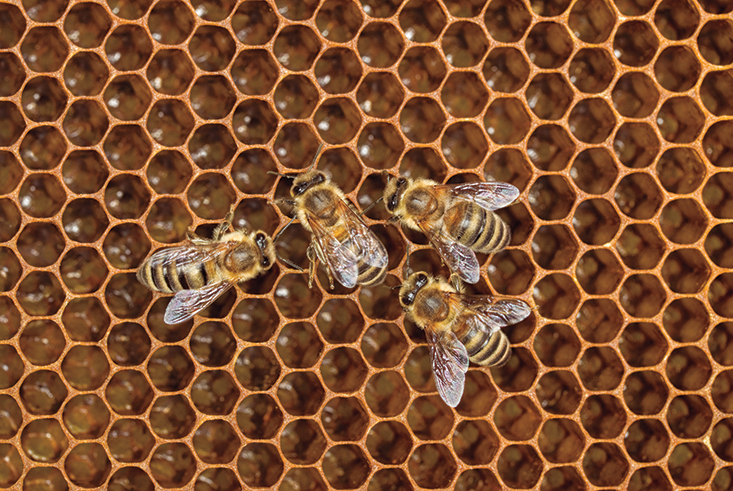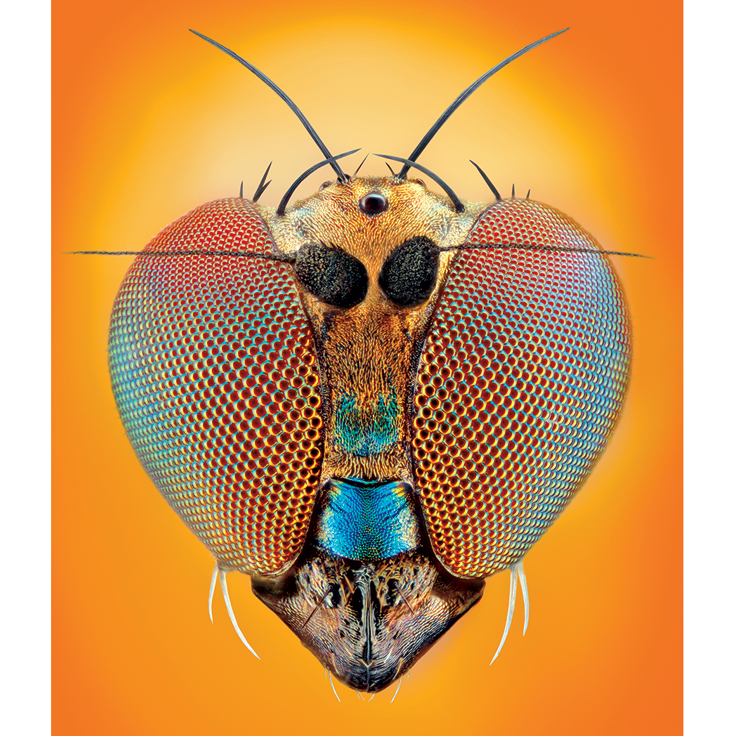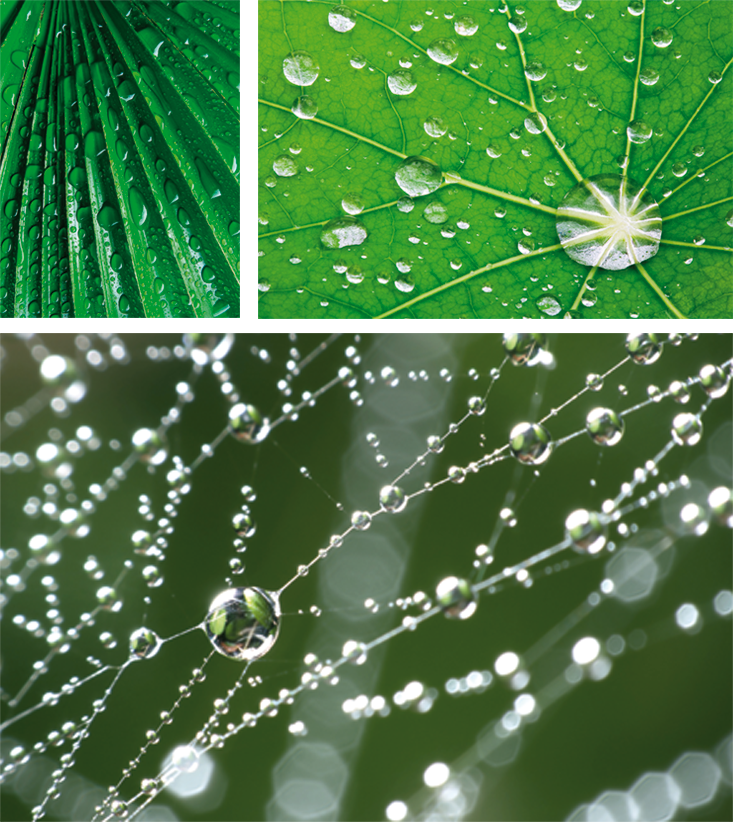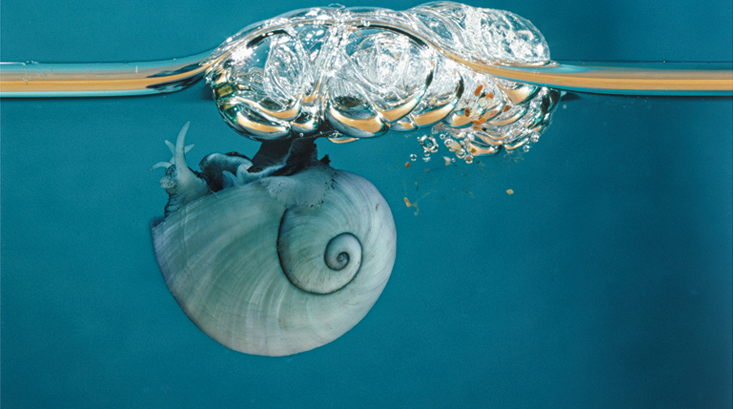How do bees do it? The honeycombs in which they store their amber nectar are marvels of precision engineering, an array of prism-shaped cells with a perfectly hexagonal cross-section. The wax walls are made with a very precise thickness, the cells are gently tilted from the horizontal to prevent the viscous honey from running out, and the entire comb is aligned with the Earth’s magnetic field. Yet this structure is made without any blueprint or foresight, by many bees working simultaneously and somehow coordinating their efforts to avoid mismatched cells.
The ancient Greek philosopher Pappus of Alexandria thought that the bees must be endowed with “a certain geometrical forethought.” And who could have given them this wisdom, but God? According to William Kirby in 1852, bees are “Heaven-instructed mathematicians.” Charles Darwin wasn’t so sure, and he conducted experiments to establish whether bees are able to build perfect honeycombs using nothing but evolved and inherited instincts, as his theory of evolution would imply.

Why hexagons, though? It’s a simple matter of geometry. If you want to pack together cells that are identical in shape and size so that they fill all of a flat plane, only three regular shapes (with all sides and angles identical) will work: equilateral triangles, squares, and hexagons. Of these, hexagonal cells require the least total length of wall, compared with triangles or squares of the same area. So it makes sense that bees would choose hexagons, since making wax costs them energy, and they will want to use up as little as possible—just as builders might want to save on the cost of bricks. This was understood in the 18th century, and Darwin declared that the hexagonal honeycomb is “absolutely perfect in economizing labor and wax.”
Darwin thought that natural selection had endowed bees with instincts for making these wax chambers, which had the advantage of requiring less energy and time than those with other shapes. But even though bees do seem to possess specialized abilities to measure angles and wall thickness, not everyone agrees about how much they have to rely on them. That’s because making hexagonal arrays of cells is something that nature does anyway.

If you blow a layer of bubbles on the surface of water—a so-called “bubble raft”—the bubbles become hexagonal, or almost so. You’ll never find a raft of square bubbles: If four bubble walls come together, they instantly rearrange into three-wall junctions with more or less equal angles of 120 degrees between them, like the center of the Mercedes-Benz symbol.
Evidently there are no agents shaping these rafts as bees do with their combs. All that’s guiding the pattern are the laws of physics. Those laws evidently have definite preferences, such as the bias toward three-way junctions of bubble walls. The same is true of more complicated foams. If you pile up bubbles in three dimensions by blowing through a straw into a bowl of soapy water you’ll see that when bubble walls meet at a vertex, it’s always a four-way union with angles between the intersecting films roughly equal to about 109 degrees—an angle related to the four-faceted geometric tetrahedron.

What determines these rules of soap-film junctions and bubble shapes? Nature is even more concerned about economy than the bees are. Bubbles and soap films are made of water (with a skin of soap molecules) and surface tension pulls at the liquid surface to give it as small an area as possible. That’s why raindrops are spherical (more or less) as they fall: A sphere has less surface area than any other shape with the same volume. On a waxy leaf, droplets of water retract into little beads for the same reason.
This surface tension explains the patterns of bubble rafts and foams. The foam will seek to find the structure that has the lowest total surface tension, which means the least area of soap-film wall. But the configuration of bubble walls also has to be mechanically stable: The tugs in different directions at a junction have to balance perfectly, just as the forces must be balanced in the walls of a cathedral if the building is going to stand up. The three-way junction in a bubble raft, and the four-way junctions in foam, are the configurations that achieve this balance.
But those who think (as some do) that the honeycomb is just a solidified bubble raft of soft wax might have trouble explaining how the same hexagonal array of cells is found in the nests of paper wasps, who build not with wax but with chewed-up wads of fibrous wood and plant stem, from which they make a kind of paper. Not only can surface tension have little effect here, but it also seems clear that different types of wasp have different inherited instincts for their architectural designs, which can vary significantly from one species to another.

Although the geometry of soap-film junctions is dictated by this interplay of mechanical forces, it doesn’t tell us what the shape of the foam will be. A typical foam contains polyhedral cells of many different shapes and sizes. Look closely and you’ll see that their edges are rarely perfectly straight; they’re a little curved. That’s because the pressure of the gas inside a cell or bubble gets bigger as the bubble gets smaller, so the wall of a small bubble next to a larger one will bulge outward slightly. What’s more, some facets have five sides, some six, and some just four or even three. With a little bending of the walls, all of these shapes can acquire four-way junctions close to the “tetrahedral” arrangement needed for mechanical stability. So there’s a fair bit of flexibility (literally) in the shapes of the cells. Foams, while subject to geometrical rules, are rather disorderly.
Suppose that you could make a “perfect” foam in which all the bubbles are the same size. What then is the ideal cell shape that makes the total bubble wall area as small as possible while satisfying the demands for the angles at the junctions? That has been debated for many years, and for a long time it was thought that the ideal cell shape was a 14-sided polyhedron with square and hexagonal faces. But in 1993 a slightly more economical—although less orderly—structure was discovered, consisting of a repeating group of eight different cell shapes. This more complex pattern was used as the inspiration for the foam-like design of the swimming stadium of the 2008 Olympic Games in Beijing.
The rules of cell shapes in foams also control some of the patterns seen in living cells. Not only does a fly’s compound eye show the same hexagonal packing of facets as a bubble raft, but the light-sensitive cells within each of the individual lenses are also clustered in groups of four that look just like soap bubbles. In mutant flies with more than four of these cells per cluster, the arrangements are also more or less identical to those that bubbles would adopt.

Because of surface tension, a soap film stretching across a loop of wire is pulled flat like the springy membrane of a trampoline. If the wire frame is bent, the film also bends with an elegant contour that automatically tells you the most economical way, in terms of material, to cover over the space enclosed by the frame. That can show an architect how to make a roof for a complicated structure using the least amount of material. However, it’s as much because of the beauty and elegance of these so-called “minimal surfaces,” as because of their economy that architects such as Frei Otto have used them in their buildings.
These surfaces minimize not only their surface area, but also their total curvature. The tighter the bend, the greater the curvature. Curvature can be positive (bulges) or negative (dips, depressions, and saddles). A curved surface can therefore have zero mean curvature so long as the positives and negatives cancel each other out.
So a sheet can be full of curvature and yet have very little or even no mean curvature. Such a minimally curved surface can divide up space into an orderly labyrinth of passageways and channels—a network. These are called periodic minimal surfaces. (Periodic just means a structure that repeats identically again and again, or in other words, a regular pattern.) When such patterns were discovered in the 19th century, they seemed to be just a mathematical curiosity. But now we know that nature makes use of them.
The cells of many different types of organisms, from plants to lampreys to rats, contain membranes with microscopic structures like this. No one knows what they are for, but they are so widespread that it’s fair to assume they have some sort of useful role. Perhaps they isolate one biochemical process from another, avoiding crosstalk and interference. Or maybe they are just an efficient way of creating lots of “work surface,” since many biochemical processes take place at the surface of membranes, where enzymes and other active molecules may be embedded. Whatever its function, you don’t need complicated genetic instructions to create such a labyrinth: The laws of physics will do it for you.
Some butterflies, such as the European green hairstreak and the emerald-patched cattleheart, have wing scales containing an orderly labyrinth of the tough material called chitin, shaped like a particular periodic minimal surface called the gyroid. Interference between light waves bouncing regular arrays of ridges and other structures on the wing-scale surface causes some wavelengths—that is, some colors—to disappear while others reinforce each other. So here the patterns offer a means of producing animal color.

The skeleton of the sea urchin Cidaris rugosa is a porous mesh with the shape of another kind of periodic minimal surface. It’s actually an exoskeleton, sitting outside the organism’s soft tissue, a protective shell that sprouts dangerous-looking spines made from the same mineral as chalk and marble. The open lattice structure means that the material is strong without being too heavy, rather like the metal foams used for building aircraft.
To make orderly networks from hard, stiff mineral, these organisms apparently make a mold from soft, flexible membranes and then crystallize the hard material inside one of the interpenetrating networks. Other creatures may cast orderly mineral foams this way for more sophisticated purposes. Because of the way that light bounces off the elements of the patterned structure, such trellises can act rather like mirrors to confine and guide light. A honeycomb arrangement of hollow microscopic channels within the chitin spines of a peculiar marine worm known as the sea mouse turns these hair-like structures into natural optical fibers that can channel light, making the creature change from red to bluish green depending on the direction of the illumination. This color change might serve to deter predators.
This principle of using soft tissues and membranes as molds for forming patterned mineral exoskeletons is widely used in the sea. Some sponges have exoskeletons made of bars of mineral linked like climbing frames, which look remarkably similar to the patterns formed by the edges and junctions of soap films in foam—no coincidence, if surface tension dictates the architecture.
Such processes, known as biomineralization, generate spectacular results in marine organisms called radiolarians and diatoms. Some of these have delicately patterned exoskeletons made from a mesh of mineral hexagons and pentagons: You might call them the honeycombs of the sea. When the German biologist (and talented artist) Ernst Haeckel first saw their shapes in a microscope in the late 19th century, he made them the star attraction of a portfolio of drawings called Art Forms in Nature, which were very influential among artists of the early 20th century and still inspire admiration today. To Haeckel, they seemed to offer evidence of a fundamental creativity and artistry in the natural world—a preference for order and pattern built into the very laws of nature. Even if we don’t subscribe to that notion now, there’s something in Haeckel’s conviction that patterns are an irrepressible impulse of the natural world—one that we have every right to find beautiful.
Philip Ball is the author of Invisible: The Dangerous Allure of the Unseen and many books on science and art.
Reprinted with permission from Patterns in Nature: Why the Natural World Looks the Way It Does, by Philip Ball, published by The University of Chicago Press. © 2016 by Marshall Editions. All rights reserved.

























